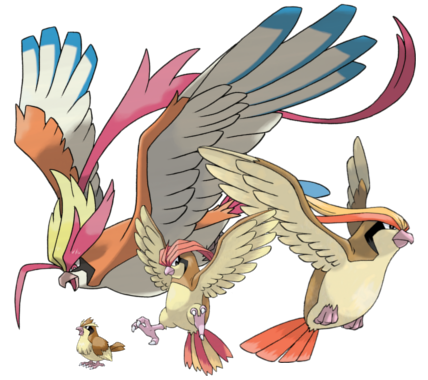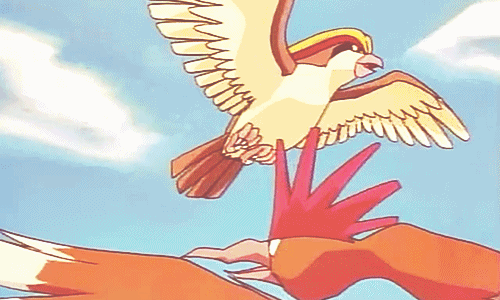Nature Note #188: Rise of the Pokédex
This week, Cornell's birding website eBird launched a new feature on their bird identification app, Merlin Bird ID. While the app has been around for a while, this is the first time that one can take a picture of a bird and use it to identify what you've seen in the wild! To most people, this is another sign of technology integrating with the modern field guides to provide more accurate ways of identifying birds. In my opinion, this has given rise to another comparison. Personally speaking, I think that the time of the Pokédex has come!
For those of you not familiar with the Pokémon franchise and its overall goal, you might have heard a little about it this July when Niantic released Pokémon Go! for Android and iPhone.
The premise of the game is to capture all 151 original Pokémon that appear randomly across the country in different habitats. Some Pokémon only appear in towns and cities, while others might only be found in the woods or near bodies of water.
After capturing a Pokémon, the data gets added to a in-game device called the Pokédex which automatically catalogs the capture and gives you information about the Pokémon in your collection. If you didn't have the opportunity to play the original Red and Blue GameBoy games when they came out in the late 90s, you probably have little to no idea about what I'm talking about. Effectively what I've been talking about this entire time is no different from digital birding or interactive stamp collecting. However, philately will only get you so far.
All jokes aside, I'm actually serious about that last point!
Even Audubon made the connection in an article this past summer. If anything, the simple act of searching for different creatures to capture/list is pretty similar to birding in and of itself. Personally, I think one of the things I enjoyed most about playing the games was trying to imagine what species the Pokémon would be analogous to in the real world. Granted that's a little hard to do with Geodude (rock with arms) and Magnemite (a literal magnetic ball), but overall, their general resemblance to animals and plants, as well as their cool designs and amazing powers was a major draw.
In the games, the first bird Pokémon you encounter are Pidgey and Spearow, before they "evolve" (transforming in a glowing ball of light not dissimilar to Sailor Moon) into bigger and more powerful Pokémon with Pidgey becoming Pidgeotto and eventually Pidgeot (not to be confused with the car) and Spearow becoming my favorite bird Pokémon of the original 151, Fearow!
Although I could go on about bird Pokémon for a while longer, I wanted to talk about the Merlin Bird ID app a little more. When I saw the newest feature this week, it reminded me of when I used to play the games on long car trips. I thought to myself about how awesome it would be to have a device that you could hold up to a bird, flower, rock, tree or what not and have it identified for you right there on the spot! Somehow I hoped something like that would be invented one day so I could identify all new birds to add to my list and photo collection.
For how much we complain about technology, what people have done with it has allowed for some amazing achievements. Not only can I now identify a bird in the field by taking a photograph of it, within the app itself, it tries to guess what you have seen by relying on information you input as well.
Just now, a crow flew by the window, so after inputting when and where I saw it (which of course was, just now, by the window) its size (crow-sized, obviously), its color (black), and what was it doing (flying), it suggested that it might be an American crow (Corvus brachyrhychos), common raven (C. corax), or one of the eighteen other species suggested. It and other bird identification apps also allow you to hear what a certain species calls and songs sound like, what habitat they prefer, what they eat, and where they can be found on the continent. Some even have listing capabilities! So if you want to get a technological edge in addition to your field guides, you should definitely check out the following:
Free to Use Apps
Pay-To-Use Apps
Photo Credits:
1. [Pokémon Go PokéDex]. Retrieved December 11th, 2016 from https://boost-rankedboost.netdna-ssl.com/wp-content/uploads/2016/07/Pokemon-Go-Pok%C3%A9dex.png
2. [Pokémon Crossroads] Retrieved December 11th, 2016 from http://static.pokemoncrossroads.com/wp-content/uploads/2015/02/18085524/Normal-Pidgey-Family.png
3. [spearow evolution] Retrieved December 11th, 2016 from https://blogger.googleusercontent.com/img/b/R29vZ2xl/AVvXsEiTZGP2Q92MdoPQmQz7fNgTUR6qIPrU5w04bXEkx4-Ytpu_H2_tqaEVZGFWEXVDXx1WIdB5toghNwk0TleSdX_yNRZzdpVBubu154uUfZ2TlMD8IZVVm23WxJRDrk-yt0LavgIz7wGkMow/s400/123.bmp
4. [Gif of Fearow and Pidgeot flying]. Retrieved December 11th, 2016 from http://axew.tumblr.com/post/77117031812
 |
| The original PokéDex from the Pokémon anime. How retro. |
The premise of the game is to capture all 151 original Pokémon that appear randomly across the country in different habitats. Some Pokémon only appear in towns and cities, while others might only be found in the woods or near bodies of water.
After capturing a Pokémon, the data gets added to a in-game device called the Pokédex which automatically catalogs the capture and gives you information about the Pokémon in your collection. If you didn't have the opportunity to play the original Red and Blue GameBoy games when they came out in the late 90s, you probably have little to no idea about what I'm talking about. Effectively what I've been talking about this entire time is no different from digital birding or interactive stamp collecting. However, philately will only get you so far.
All jokes aside, I'm actually serious about that last point!
Even Audubon made the connection in an article this past summer. If anything, the simple act of searching for different creatures to capture/list is pretty similar to birding in and of itself. Personally, I think one of the things I enjoyed most about playing the games was trying to imagine what species the Pokémon would be analogous to in the real world. Granted that's a little hard to do with Geodude (rock with arms) and Magnemite (a literal magnetic ball), but overall, their general resemblance to animals and plants, as well as their cool designs and amazing powers was a major draw.
 |
| Pidgey, Pidgeotto, Pidgeot, and Mega Pidgeot (smallest to largest) |
 |
| Spearow and its evolution, Fearow. |
For how much we complain about technology, what people have done with it has allowed for some amazing achievements. Not only can I now identify a bird in the field by taking a photograph of it, within the app itself, it tries to guess what you have seen by relying on information you input as well.
 |
| Fearow vs. Pidgeot in the anime |
Free to Use Apps
Pay-To-Use Apps
Photo Credits:
1. [Pokémon Go PokéDex]. Retrieved December 11th, 2016 from https://boost-rankedboost.netdna-ssl.com/wp-content/uploads/2016/07/Pokemon-Go-Pok%C3%A9dex.png
2. [Pokémon Crossroads] Retrieved December 11th, 2016 from http://static.pokemoncrossroads.com/wp-content/uploads/2015/02/18085524/Normal-Pidgey-Family.png
3. [spearow evolution] Retrieved December 11th, 2016 from https://blogger.googleusercontent.com/img/b/R29vZ2xl/AVvXsEiTZGP2Q92MdoPQmQz7fNgTUR6qIPrU5w04bXEkx4-Ytpu_H2_tqaEVZGFWEXVDXx1WIdB5toghNwk0TleSdX_yNRZzdpVBubu154uUfZ2TlMD8IZVVm23WxJRDrk-yt0LavgIz7wGkMow/s400/123.bmp
4. [Gif of Fearow and Pidgeot flying]. Retrieved December 11th, 2016 from http://axew.tumblr.com/post/77117031812


Comments
Post a Comment